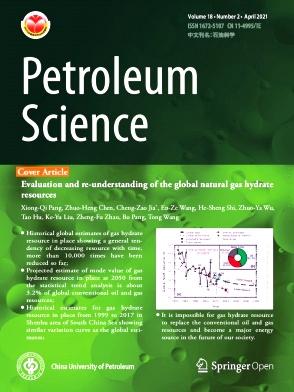Effective pure qP-wave equation and its numerical implementation in the time-space domain for 3D complicated anisotropic media
IF 6
1区 工程技术
Q2 ENERGY & FUELS
引用次数: 0
Abstract
Seismic anisotropy has been extensively acknowledged as a crucial element that influences the wave propagation characteristic during wavefield simulation, inversion and imaging. Transversely isotropy (TI) and orthorhombic anisotropy (OA) are two typical categories of anisotropic media in exploration geophysics. In comparison of the elastic wave equations in both TI and OA media, pseudo-acoustic wave equations (PWEs) based on the acoustic assumption can markedly reduce computational cost and complexity. However, the presently available PWEs may experience SV-wave contamination and instability when anisotropic parameters cannot satisfy the approximated condition. Exploiting pure-mode wave equations can effectively resolve the above-mentioned issues and generate pure P-wave events without any artifacts. To further improve the computational accuracy and efficiency, we develop two novel pure qP-wave equations (PPEs) and illustrate the corresponding numerical solutions in the time-space domain for 3D tilted TI (TTI) and tilted OA (TOA) media. First, the rational polynomials are adopted to estimate the exact pure qP-wave dispersion relations, which contain complicated pseudo-differential operators with irrational forms. The polynomial coefficients are produced by applying a linear optimization algorithm to minimize the objective function difference between the expansion formula and the exact one. Then, the developed optimized PPEs are efficiently implemented using the finite-difference (FD) method in the time-space domain by introducing a scalar operator, which can help avoid the problem of spectral-based algorithms and other calculation burdens. Structures of the new equations are concise and corresponding implementation processes are straightforward. Phase velocity analyses indicate that our proposed optimized equations can lead to reliable approximation results. 3D synthetic examples demonstrate that our proposed FD-based PPEs can produce accurate and stable P-wave responses, and effectively describe the wavefield features in complicated TTI and TOA media.
三维复杂各向异性介质的有效纯qp波方程及其在时空上的数值实现
在波场模拟、反演和成像中,地震各向异性是影响波传播特性的一个重要因素,已被广泛认为。横向各向同性(TI)和正交各向异性(OA)是勘探地球物理中两类典型的各向异性介质。与TI和OA介质中的弹性波动方程相比,基于声学假设的伪声波方程(pwe)可以显著降低计算成本和复杂度。然而,当各向异性参数不能满足近似条件时,现有的pwe可能会遭受sv波污染和不稳定。利用纯模波动方程可以有效地解决上述问题,产生无伪影的纯纵波事件。为了进一步提高计算精度和效率,我们建立了两个新的纯qp波方程(PPEs),并举例说明了三维倾斜TI (TTI)和倾斜OA (TOA)介质的时域数值解。首先,采用有理多项式估计纯qp波色散关系,该色散关系包含复杂的非理性形式的伪微分算子。多项式系数的产生采用线性优化算法,使展开公式与精确公式的目标函数差最小。然后,通过引入标量算子,利用时域有限差分(FD)方法有效地实现了优化后的ppe,从而避免了基于谱的算法的问题和其他计算负担。新方程结构简洁,实现过程简单。相速度分析表明,我们提出的优化方程可以得到可靠的近似结果。三维合成实例表明,本文提出的基于fd的ppe能够产生准确、稳定的纵波响应,并能有效地描述复杂TTI和TOA介质中的波场特征。
本文章由计算机程序翻译,如有差异,请以英文原文为准。
求助全文
约1分钟内获得全文
求助全文
来源期刊

Petroleum Science
地学-地球化学与地球物理
CiteScore
7.70
自引率
16.10%
发文量
311
审稿时长
63 days
期刊介绍:
Petroleum Science is the only English journal in China on petroleum science and technology that is intended for professionals engaged in petroleum science research and technical applications all over the world, as well as the managerial personnel of oil companies. It covers petroleum geology, petroleum geophysics, petroleum engineering, petrochemistry & chemical engineering, petroleum mechanics, and economic management. It aims to introduce the latest results in oil industry research in China, promote cooperation in petroleum science research between China and the rest of the world, and build a bridge for scientific communication between China and the world.
 求助内容:
求助内容: 应助结果提醒方式:
应助结果提醒方式:


